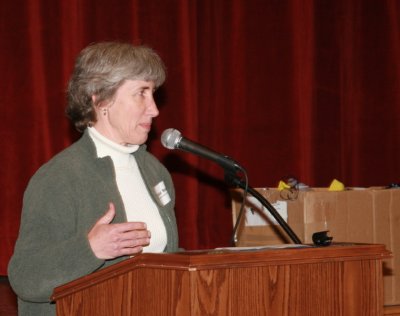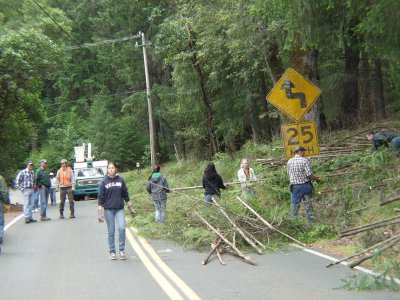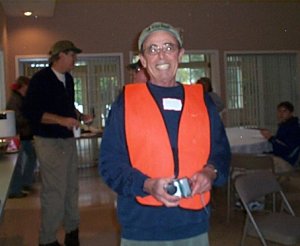This is the third installment in Lake County News' ongoing series, Feeding Awareness: Food Insecurity in Lake County.
LAKE COUNTY – They're not a company. They're not a club. They're not a registered nonprofit. They don't do any fundraising. So, just what is the Lake County Hunger Task Force?
An active advocacy group for food insecurity, hunger, and health education, the Hunger Task Force (HTF) starts up and maintains multiple community gardens to help feed Lake County's hungry and also
holds events and seminars on nutrition to help fight poor health and obesity.
"We figured we didn't need another agency," laughs nutrition guidance counselor Ron Jones, one of the founding and current active members.
So, they've kept it simple: "No one should go to bed hungry in Lake County" – a motto that completely defines HTF's intentions and efforts.
Entirely volunteer-based, the group was formed in 2000 after Evelyn Conklin-Ginop initiated a study on hunger in Lake and Mendocino counties.
HTF works with Lake County Community Action Agency (LCCAA), AmeriCorps, the Rural Food Project, Lake County First Five, the Office of Education, local senior centers and other food pantries.
The connection? "We contribute food to their programs," says Lorrie Gray, community garden coordinator of HTF and also a founding member.
"We applied to the Lake County Wine Alliance some years ago for a grant and we received it," explains Jones. They've been operating on it for several years, using the grant money to purchase equipment and
supplies.
HTF grows fruits and vegetables in multiple community gardens throughout the county. Typically, seeds are donated to HTF – sometimes space in a private garden is donated – and Gray and HTF member Pat Schuman of Lake County Social Services are usually the ones to initially plant the seeds and sometimes weed and garden, as well. Gardens are maintained by community organizations, schools, and other individual volunteers throughout the county.
Sometimes, property owners just want somebody to come out and help get rid of the overabundance of fruit or vegetables.
Volunteers who maintain the gardens are welcomed to eat from them, and the abundance of fresh fruits and vegetables goes to food pantries around the county.
Many of the volunteers experience some level of food insecurity or poor nutrition, and they directly benefit from the program.
Lou Denny of LCCAA, another active member of HTF, says the group especially targets low-income families with children. "It's important for them to enhance their ability to get food because there is a
direct relationship between healthy food and achievement in academics."
"As part of the garden program, we try to get fresh fruits and vegetables into the hands of people who can't afford them," says Gray.
Gardens are even maintained in the winter, when spinach, lettuce, chard, kale, and other greens can be harvested.
"Most people we feed are the working poor," Denny adds. "They have jobs, but the money just doesn't stretch."
"The main reason we started the community gardens here is that during the summer time students are not getting subsidized lunches and food from school," says Gray.
In the participating schools, the gardens double as an educational tool, so that children learn, according to Jones: "You take care of the garden. You plant it, you water it, and then you get to eat from it."
Jones also holds educational seminars throughout the county that address all groups of people on how to read labels, how to manage weight without fancy diets, and how to make healthy meals easily.
"Ron Jones was one of the pioneers of the county for addressing food insecurity, hunger and nutrition," says Denny.
The other prominent members not yet mentioned are Tammy Alakszay of AmeriCorps, Bev Bergstrom of Senior Support Services, Annie Barnes from Tribal Health, nutritionist and WIC advisor Helen Sandager, and Hedy Montoya from the Rural Food Project.
People always are jumping on board to help out, too, according to Denny. Barry Miller, for example, is a tutor and professional gardener who is starting a community garden at Clearlake Community School in Clearlake.
"We do a lot of networking with people who want to solve problems with hunger," explains Gray. "For instance, we were granted permission from the Steele Wines farmers' market to set up an informational booth on the first Saturday of each month."
The Hunger Task Force, in conjunction with LCCAA, participated in the 2005 Hunger Survey for Lake County, conducted by Pacific Union College out of Angwin. The results were compiled into a booklet, which is available to all interested agencies.
"A big part of our group is addressing issues of health, growth, and, of course, longevity for seniors," says Denny.
Each year, HTF holds a countywide food forum on hunger and nutrition, and all are welcomed to attend.
HTF also gives free canning lessons each fall to best teach people how to use excess fruits and vegetables. The classes are taught by Lorrie's husband Brian. Every student engages in hands-on learning of how to can tomatoes and pears, and each participating household receives a water bath canner, jar lifter, book, and a case of canning jars to use at home.
But that's not all. HTF is always on the move.
"For several years," Lorrie Gray explains, "we've participated in Make a Difference Day – a nationwide volunteer day held the last Saturday in October. They pick one organization per county is to honor their efforts; we were the honorees chosen from Lake County twice."
During Make a Difference Day, HTF in collaboration with AmeriCorps and other organizations, collects nonperishable food in front of Lake County's supermarkets to give to local food banks.
Hunger Action Day is May 8, and people from all over California join in Sacramento to educate their legislators about hunger and nutrition.
Explains Denny: "When we try to serve nutritious foods, it really has a greater impact on our society and its productivity. And it cuts down on healthcare costs."
He continues: "There are 2 million people in California who are eligible for food stamps who do not get them because it's a long process, they have to be fingerprinted, and various other reasons. We are pushing for some bills that will streamline that."
"The big stumbling block," adds Gray, "is a sense of shame. They're ashamed to take a handout and that's why we can't get them to sign up. There are still hungry people, and as a county with an abundance of fresh fruit and vegetables, we're trying to fill that void."
The Lake County Hunger Taskforce meets every fourth Monday of the month to deal with hunger issues in Lake County. The informal meetings are held at various sites around the county from 11:30 am. to 1 p.m. Most attendees bring lunch and drop-ins are welcome. Membership is not restrictive at all.
The next meeting of the Hunger Task Force will be held Monday, April 23, at St. Joseph's Catholic Church, 21396 Highway 175 in Middletown.
For more information on the Lake County Hunger Task Force, contact Lorrie Gray, 277-9227.
E-mail Penny Dahl at This email address is being protected from spambots. You need JavaScript enabled to view it..
{mos_sb_discuss:2}

 How to resolve AdBlock issue?
How to resolve AdBlock issue? 












